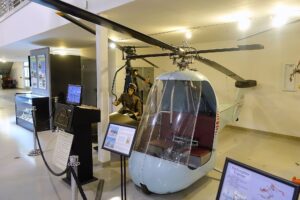The Hiller 8RJ2B ramjet was used to power the YH-32 Hornet experimental helicopter.
The Hiller YH-32 Hornet (company designation HJ-1) was an American ultralight helicopter built by Hiller Aircraft in the early 1950s. It was a small and unique design because it was powered by two Hiller 8RJ2B ramjet engines mounted on the rotor blade tips which weigh 13 lb (5.9 kg) each and deliver an equivalent of 45 hp (34 kW) for a total of 90 hp (67 kW). Versions of the HJ-1 Hornet were built for the United States Army and the United States Navy in the early 1950s.
The Hiller Museum identifies the YH-32A, named the Sally Rand, as the first helicopter gunship.
Design and Development
The Hiller HJ-1 Hornet was an early attempt to build a jet-powered helicopter using ramjets. Before that there had been experiments with the XH-26 Jet Jeep tip rotor pulse jets. The HJ-1 ramjet tipped rotor propels the rotor and the aircraft. Unlike a conventional helicopter, this mechanically simple design avoids the need for a tail rotor.

Unfortunately, the tip speeds on helicopter rotor blades are subsonic, and ramjets are inefficient at subsonic speeds due to low compression ratio of the inlets. Therefore, the Hornet suffered from high fuel consumption and poor range. Also, the vehicle suffered from low translational speeds, and the ramjet tips were extremely noisy. In the event of power loss, autorotation was found to be difficult due to the drag from the ramjet nacelles.
The vehicle exhibited powerful lifting capacity, and there was some hope for military uses, but the high noise, poor range, and high night-time visibility of the ramjet flames failed to attract sales.
For more information see the Wikipedia Article about the Hiller YH-32 Hornet.
